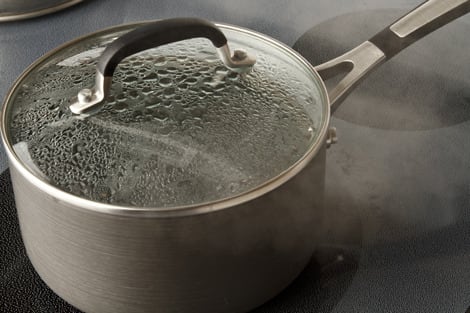Faster Cooking and Tastier Food: A Crash Course in 7 Steps
Even if your culinary aspirations start and end at frozen pizza, you can still be smart about oven use.
 Credit:
Credit:
Recommendations are independently chosen by Reviewed's editors. Purchases made through the links below may earn us and our publishing partners a commission.
Covered Pots Boil Faster
If you leave boiling water uncovered, you're doing it wrong. The lid traps heat, so the water temperature increases faster, saving energy and getting food to your plate sooner. It's a no-brainer.

One theoretical caveat: When steam gets trapped, it raises the pressure inside the pot, which increases the boiling point. But this will never matter in practice. Covers aren't airtight—most of them even have small vent holes—so vapor always escapes even as the heat gets held in.
Use The Correct Burner
On older stoves, big burners boil, and small burners simmer. Simple. On new ranges, all bets are off. Different burners serve different purposes, like a power burner for boiling and a low-temperature burner for simmering—even if they all look the same. The distinctions aren't usually printed on the stove top because too much text makes for ugly design (and is hard to read through crusty tomato sauce).
So what to do? Read the manual, seriously. If you can read a recipe, you can read your oven's instruction booklet. If you don't have a paper copy, find the model number inside the oven door, punch it into Google, and poke around until you find a PDF. Just do it.
Size Matters
Small spaces are easier to heat than big spaces, so if something fits in your toaster oven, you might as well cook it in there. Bagel bites, vegetarian burger patties, and day-old pizza are all prime toaster-oven candidates. Lasagna, quiche, and pork roll are usually better off in the big-boy oven.

Preheat Appropriately
Those cooking times on a box of frozen pizza? They only work if you preheat the oven. Once an oven hits 130 degrees Fahrenheit, it starts to cook the edges of most dishes, but won't heat the center. So if you throw your DiGiorno's Supreme into the oven as you turn it on, you can expect a nice, crisp crust and a doughy, undercooked center topped with half-melted cheese. It can even get worse: the pizza can melt through the grates and makes a mess. You're gonna wish it was delivery.
The solution? Preheat the oven for 10 minutes. Food cooks more evenly in a consistently hot environment. The exception? Don't preheat your broiler for more than about 2 minutes. You're basically cooking next to an open flame, so you don't really need to wait for the compartment to heat up. This cooking method uses radiant heat, not just a hot oven cavity.
Keep the Oven Door Closed
Brownies are delicious. But every time you open the oven to peek at the flaky crust or savor the sweet aroma, you lose heat and delay the process. Patience, Iago!
Convection Ovens Cook Faster
If you're lucky enough to own an oven with a convection fan, use it! It's the same tech that transforms your Dunkin Donuts breakfast sandwich from a gross, semi-frozen puck into hot gross food in about 20 seconds.
Alright, fast food is a bad example. But convection ovens are excellent. They blow very hot air at your food, cooking it faster and more evenly than a conventional oven can hope to. It's generally found only in mid- to high-end ranges these days (and some smaller toaster ovens), but if you've paid for it, you're crazy if you don't use it.
Clean Up Your Mess
Burnt cheese doesn't lend the same subtle, savory smoky flavor as hickory chips do, so you might want to clean up your spillage. Almost all ovens have self-cleaning features, and it's always very effective—it gets hot enough to turn organic matter into dust. Curiously, many high-end ovens tend to not have self-cleaning features, so they'll need to be hand-cleaned.
Do you have any smart cooking tips? Share them in the comments below!
Photo: khawkins04, Flickr [CC-BY-3.0]

